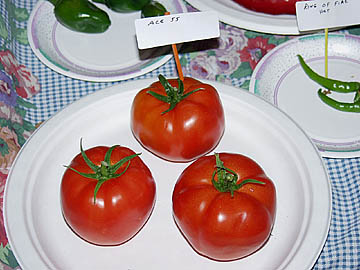
All the tomato and pepper varieties were planted from seed, in our greenhouse, between February 4-12, 2002. Most came from either the Tomato Growers Supply Company or Totally Tomatoes. The descriptions (in the quotation marks) are theirs.
As the seasoned garden catalog peruser knows, seed and plant descriptions are akin to Playboy Playmate of the Month Biographies: difficult to take seriously. For instance, the Playmate who says her favorite recreation is, "a walk along a secluded beach" can be safely translated as, "I want to go to Fiji and I want to go now!" Or, if she says her favorite male trait is "a sense of humor", that can be taken to mean, "chuckles to himself as he opens up his wallet to pay for that $25,000 diamond trinket."
In garden catalogs, here are some commonly used expressions, and what they really mean:
"vigorous": will not only take over your garden, but will house a large family of rodents by the end of summer.
"old time favorite": this may be the tomato that killed your great grandpa; we can't be sure, though.
"crack-free": the skin is as hard as a rock
"high yields": your neighbors will shut their blinds when they see you walking up their driveway, lugging that damn shopping bag...again.
"spreading vines": kiss your miniature poodle goodbye.
"self-sows easily": by any other name, a weed
"best for storage": slice it with a chain saw
"unique heirloom": old, ugly
"unusual heirloom": old, really ugly
"unusual nutty flavor": be prepared to spit.
"Days" refers to the number of days it takes, on average, from seed planting to harvest. "Indeterminate" tomatoes tend to produce all season, usually on sprawling vines that need a solid support system, such as five feet high concrete wire shaped into a three foot diameter cage. "Determinate" tomatoes usually all ripen about the same time, ideal for canning purposes.
Ace 55

"8 to 10 oz. round, red fruit have very good tomato flavor and excellent yields. This variety is lower in acid than most other tomatoes and often recommended to people who are on a low-acid diet. Determinate. 80 days."
For its uniformity of large size, prolific production throughout the growing season as well as outstanding flavor, the Ace 55 is the 2002 Farmer Fred Taste Test Winner! A UC Cooperative Extension taste test winner in 1999. I was happy to redicsover this old favorite in 2001. In our garden, it produced fruits well over one pound, great for slicing.
Better Boy
"One of the most popular hybrid tomatoes. A midseason tomato with plump juicy, deep red tomatoes that often weigh in at more than one pound. Indetermnate. Brilliant scarlet skin and flesh that's juicy yet firm. It s heavy foliage naturally protects fruits from sunscald, while spreading vines produce in abundance. 75 days."
Translation: give this one plenty of room!
Celebrity
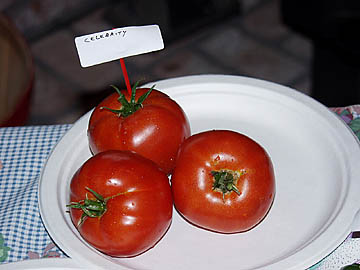
"A dependable semi-determinate, medium sized tomato that's great fresh or as a canning tomato (the skin comes off quite easily). A 1984 All-America Selections winner. Exceptionally flavorful, firm 7 to 8 oz. fruit on strong vines with good cover and outstanding disease resistance. Highly productive and widely adaptable. 70 days."
This is the variety that gets planted in our garden year after year. Good looking and good tasting, very productive, good for canning, too (skin comes off easily).
Dixie Golden Giant
"Fabulous sweet, fruity taste in a huge, clear, lemon-yellow beefesteak tomato make this variety outstanding. Some of the 1 to 2 pound fruits have a pink blush on their blossom ends. This is an heirloom variety that grows on large plants andy yields a good harvest. Esceellent flavor and not so late as some others of its type. Indeterminate. 85 days."
A 2001 taste test winner at Morningsun Herb Farms annual tomato tasting party in Vacaville.
Empire
Another trial packet from Totally Tomatoes. All it says is, "determinate". OK, I'll give it a shot; I'm easy.
First Lady II
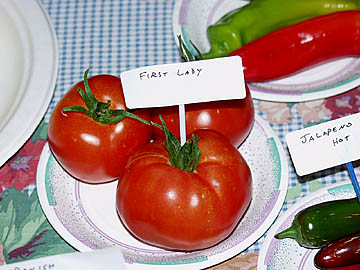
"Extra-early, full-season bearer of mid-sized and tasty fruits that are crack-resistant and perfect for the early market. Considered by many to be the most flavorful of all hybrid varieties. Red, smooth-skinned, round fruits cluster on the vine. Indeterminate. 66 days."
I'm growing this one for the second time this year. 2001 Farmer Fred Taste Test Winner. Blemish-free, very flavorful and juicy; produces throughout the season.
Green Zebra
"A unique and delicious salad tomato, three ounce green fruits ripen to amber-green with darker green stripes. The light green flesh is very flavorful, sweet yet zingy. Indeterminate. 75 days."
A freebie from Tomato Growers Supply Company. We'll see.
Jolly
"2001 All American Selection. A large pink fruited cherry tomato that will change the minds of those who feel that most cherry tomatoes lack flavor. Good acid content and exceptionally sweet flavor in meaty fruits that are produced in clusters of 9 to 14, weighing about 1 and a half ounces each, with a distinct peach shape. Not prone to cracking. Indeterminate. 70-75 days."
New for us. It has a ways to go to unseat Sweet Million from its top spot.
Lemon Boy
This VFN-resistant hybrid will be our first "Yellow" tomato. Tomato Growers Supply Cmpany describes it as "vigorous" (oh-oh) with loads of "mild, sweet, tangy" fruits about eight ounces each. Indeterminate. 72 days.
Polish Linguisa
"19th centruy heirloom, Loaded with vitamins, fiber and postassium, but low in fat and sodium. Vigorous plants set more fruit than most heirlooms. Fruits are 7 to 10 ounces and pie shaped. Flesh is soft with a very sweet flavor. Indeterminate. 73 days."
Another first time test for us.
Principe Borghese
These seeds were given to us at a recent Home and Garden Show. According to the "Terre de Semences" catalog of England, the Principe Borghese "In Italy is one of the main varieties for drying in the sun or for preserving Plum shaped fruits growing in bunches. Requires staking, few seeds and not very juicy. Determinate; plants can be dried. 75 days."
Saint-Mar
"A very productive, elongated tomato with firm flesh. Ideal for sauces and preserving," says the "Terre de Semences" catalog. Also a seed gift; a first for us.
Southern Night
"Rich taste from a Russian heirloom. Medium to large fruits range in color from a dark gray-pink to deep mahogany. Green shouldered, slightly flattened oval fruits are three to five inches in diameter, and weigh up to 10 ounces. Potato-leaf type foliage. Known for its unusual color and good taste. Wonderful canned, especially when mixed with other tomatoes. Sweet yet acid. Performs best in warm areas, where it turns the deepest 'black' color. Determinate. 65-85 days."
Another 2001 taste test winner at Morningsun Herb Farms. But why do you need to mix it with other tomatoes when canning? If kids will eat green ketchup, won't they eat a mahogany-colored sauce?
Sweet Million
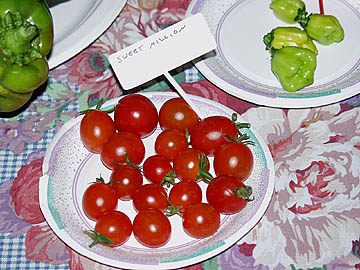
"An improved version of Sweet 100, this variety offers the same wonderful flavor and yields, but much better disease resistance and tolerance to cracking. Incredibly long clusters of 1 inch dark red fruit grow on tall, vigorous plants. 65 days. My favorite cherry tomato, great for snacking directly off the vine."
Once again, Sweet Million is a 2002 Farmer Fred Taste Test Winner ! A 2001 Farmer Fred Pepper Party Taste Test Winner (yes, we sample tomatoes, too). This is a productive cherry tomato, with tons of fruit on an indeterminate vine that tops out at six feet tall. And sweet! The small (one inch) fruit are great for snacking. I add this tomato variety to my chili instead of sugar. If I was forced to only grow one tomato plant, this would be it. I grow this variety each year for a number of reasons; not the least of which: my dentist requests a plant for himself each spring. I trade him for toothpaste and floss.
Hot Peppers
Ancho Villa
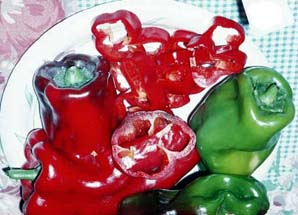
"Better yields and larger fruits are what this hybrid offers over open-pollinated ancho varieties. Extra-large ancho peppers turn from dark green to red, but are most often used in the green stage for making chiles rellenos. Once ripened to red, they are popular for drying. Expect abundant harvests throughout an extended season and tall plants that are resistant to potato virus Y and pepper mottle virus. 78 days."
2002 Farmer Fred Taste Test Winner ! A 2000 Farmer Fred Pepper Party Taste Test winner, great for roasting.
Carribean Red
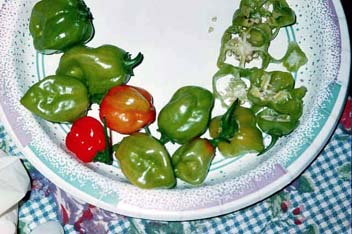
"Seed for this habanero variety was found in the Caribbean, and then improved, resulting in a uniform, fiercely hot pepper that is way hotter than the regular orange habanero. Dried samples of Caribbean Red measured 445,000 Scoville units whereas regular habanero tested at about 260,000 Scovilles. This pepper must be used carefully, but is wonderful for salsas, marinades, and making your own hot sauce. Bright red, wrinkled fruits are about 1-1/2 inches deep and 1 inch wide and have flavor with fruity overtones. 110 days to red."
The ultimate tastebud killing machine. It burns to smell it. Wear gloves when handling! Oddly enough, some people I know (hello, Gabe) are requesting this pepper. They're nuts; or, they have cast iron lips, tongue, throat, stomach and intestines.
Fatalii
"Fiery hot, wrinkled yellow peppers are related to habanero, and are at least as hot, if not hotter. The searing hear has an excellent, citrus-like flavor that can be appreciated in the seconds before the heat sets in. Orginally from Africa, these plants become three to four feet tall, maturing abundant crops of fruit earlier than plants of habanero. Peppers are two to three inches long with a wide top that tapers tdown to a point, and are shriveled all over."
Get ready, Gabe.
Habanero Red
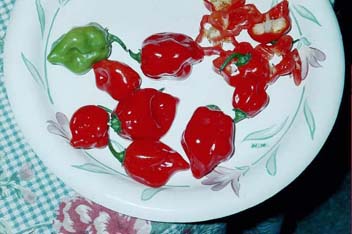
"This bright red version of Habanero is one hot pepper. The fruit shape and size are much like the regular Habanero, wrinkled 1 inch to 1-1/2 inch long peppers with a tapered end. These peppers turn a brilliant red upon maturity and grow in abundance on 3-1/2 foot tall plants. Hot enough to suit even the most dedicated chile lover. 90 to 100 days."
Very hot! This one got great reviews at the August 2000 Farmer Fred Pepper Party, as well as being a 2001 Farmer Fred Pepper Party Taste Test Winner. Many people run for liquid relief after tasting this tear jerker, which has been rated at 285,000 Scoville Heat Units (a jalapeno, by comparison, is about 3,000 SHU). Still, some say it has a wonderful flavor (as they wipe the tears from their eyes!)
Inferno

"Hybrid Hungarian hot wax pepper. Very productive plants bear 8-inch long, very hot banana peppers with medium-thick flesh. They mature from yellow to red and are larger than older, open-pollinated types of Hungarian Wax. Great for pickling. 60 days."
A 2002 Farmer Fred Taste Test Winner as well as the 2001 Farmer Fred Taste Test Winner. Warm to hot, depending upon your tolerance. This Hungarian Wax pepper is not too hot (about 1,000 Scoville units, I reckon). The heat is more of a delayed reaction (tricky!), allowing you to enjoy the spicy flavor first.
Jalapeno M
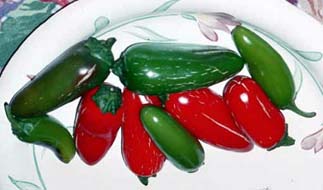
"Fiery, thick-walled peppers grow 3 in. long and 1-1/2 inches wide, with rounded tips. Dark green at first, then turning red. Good for fresh use or pickling; famous for nachos and other Tex-Mex dishes. 75 days."
My favorite Jalapeno-type pepper, great for topping on that tortilla chip.
Nu Mex Joe E. Parker
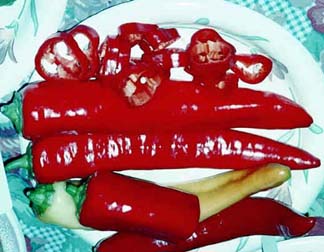
"This is a very productive version of NuMex 6-4 that offers more uniform peppers. 6 to 7-inch thick-fleshed peppers turn from green to red and are relatively mild to medium in flavor. Ripens earlier than most other peppers of its type. 65 days."
The overall winner of the Farmer Fred Pepper Party Taste Tests in August, 2000. Great in chili!
Pablano Rancho
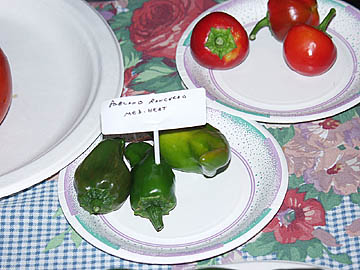
From Lake Valley Seed, which describes this hot pepper variety as: "...the real thing for authentic chile rellenos...a mildly hot flavor with medium thick flesh, perfect for stuffing. One of the most productive and best flavored varieties. Also known as the Ancho Chili when smoked and dried."
Note: we do not recommend smoking peppers. Oh wait a minute, they mean with a smoker...
Scotch Bonnet
"A Capsicum chinese very similar to Habanero, but later in maturity with fruit that is not quite as long. Tall, vigorous plants bear peppers that begin as green, but mature to red. Fruity aroma and same blistering heat as the Habanero. 120 days."
Again, wayyyyyy too hot for my system; I reckon it's in the range of the Habanero Red, about 285,000 Scoville Units.. But some, such as Gabe the Gourmand (after several margaritas), claims it has a wonderful taste.
Spanish Spice
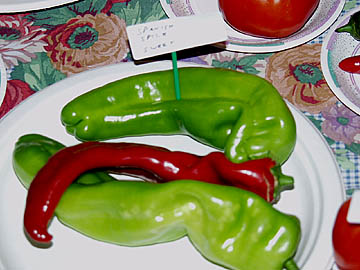
"Spicy Mediterranean flavor that is neither hot nor sweet. 7 inches long, dark green peppers are great for grilling or frying because their thin walls cook quickly. Peppers look something like a wrinkled Anaheim chile. Continued production throughout the season. 63 to 68 days."
Jeanne likes it. Enough said.
Yellow Mushroom
"So named because of its shape resembling a mushroom, it is also sometimes known as a squash pepper for its resemblance to a patty-pan squash. Maturing to light yellow, then finally to golden, this is an extremely hot fruit that is related to habanero. Abundant harvests of these thin-skinned, 2 inch peppers, which are especially good pickled. 80 days."
A new one for us. We'll let you know.
Mild Peppers:
Anaheim
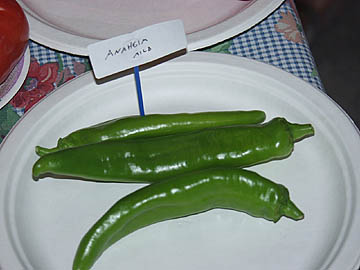
"Also know as the 'New Mexican Chile', this moderately pungent fruit is deep green, but turns red at full maturity. Very smooth peppers are 7-1/2 inches long and 2 inches wide and borne on tall, productive plants that offer good foliage cover for the fruit. Tobacco mosaic virus resistant. Excellent for canning, freezing or drying. 75 days."
OK, it's not really "mild". But it isn't all that hot, either. My favorite for nachos.
Blushing Beauty
"All America Selections Winner. This sweet bell pepper never is green. Instead, it first appears as ivory, then blushes to light red and orange-red, and finally to deep scarlet, with fruit in several color stages at one time on the plant. Thick-walled, heavyweight peppers are orange, about 4 inches long and wide, and 4-lobed with fine, sweet flavor. Compact plants produce abundantly with resistance to a number of viruses and 3 races of bacterial leaf spot. 72 days."
A new one for us.
Flamingo

"Vigorous hybrid (F1) plants produce large, thick walled fruit that change color as they mature: from ivory-yellow to pink, to orange-red. Sweet fleshed, good for cooked dishes and salads alike. Resistant to TMV. 66 days." From Harris seeds. Here's a sweet pepper that we plant every year. It's tasty and colorful!
Giant Aconcagua
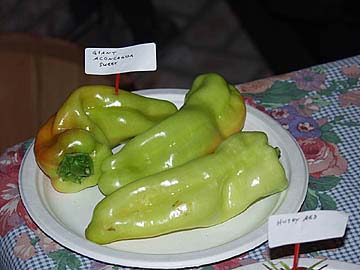
"70 days. Flavor as sweet as apples! Gourmet chefs use them in salads, stir-fried, roasted and stuffed. Long fruits grow up to 11" and can weigh up to 12 ounces. Best flavor at light green stage."
2001 Farmer Fred Taste Test Winner. Big and cylindrical, this one is eleven inches long, over 10 oz. in weight, and won raves munched on raw; or cooked, stuffed with tomatoes and beef. I still prefer its similiar cousin, the...
Giant Marconi
"72 days. 2001 AAS Winner! While not technically a Marconi Pepper, it displays so many similar traits it has earned the name! Large, tapered, elongated fruits grow 8" by 3", with a sweet, smoky flavor that's equally delectable when fruits are eaten green or red, fresh or grilled. Widely adaptable, it produces larger than normal crops just about anywhere. Withstands severe weather with excellent disease resistance."
A 2002 Farmer Fred Taste Test Winner as well as the 2001 Farmer Fred Taste Test Winner. This 2001 AAS Award Winner has (in my opinion) more flavor than the Giant Aconcagua.
Gypsy
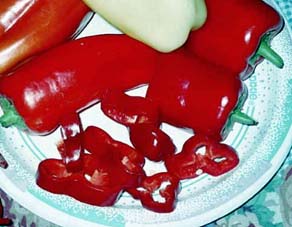
"60 days. 1981 AAS Winner. An extremely early, heavy producer. Plants grow to 18", bearing wedge-shaped, tasty, sweet peppers with sturdy walls and crunchy, firm, sweet, flesh. A very reliable yielder, all season long. Tobacco Mosaic Virus resistant."
I grow this one every year. Dependable and colorful, the Gypsy starts off as a pale yellow, and eventually darkens to orange-red.
Luigi
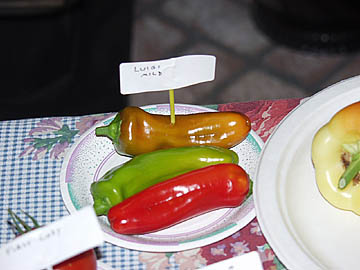
"62 days. Bred for Italians, and does their cuisine proud! Sweet and crisp enough to enjoy raw, but is at its very best when lightly cooked. And the yield-Luigi averaged an astounding 45 peppers per plant in recent trials! Fruits are cylindrical, elongated (4-5") and tapered, most often used green but will mature to a deep red. Very versatile in the kitchen! Plants grow to about 24", with excellent disease resistance."
I am not sure if the prolific use of exclamation points by the folks at Totally Tomatoes is indicative of their fondness for this variety; perhaps they felt that the Cap-1 key was getting lonely. Still, the Luigi was a 2001 Farmer Fred Taste Test Winner. Good raw, excellent lightly grilled. The cylindrical-shaped fruits of the Luigi are about five inches long, with crunchy, firm sweet flesh.
Peto Wonder
"Very large, thick-walled European type bell pepper. Elongated shape is 6-1/2 inches long and 4-1/2 inches wide at the shoulder. Dark green peppers are sweet and turn deep red at full maturity. When red, this pepper has more vitamin C than an orange. Vigorous plants are tobacco mosaic virus resistant. 75 days."
Another new taste test for our garden.
Spanish Spice

63-68 days. A thin-walled (good for cooking), seven-inch long sweet, dark green pepper that adds a flavor neither hot nor sweet when added raw to a salad, but imparts an excellent spicy flavor that even the most finicky tasters (especially those who are not fond of mildly warm peppers) found pleasing. Prolific producer.
X3R Red Knight
A trial packet from Totally Tomatoes, with no accompanying information about it, other than the words, "sweet bell pepper". I'll let you know.
Get ready to clear your sinuses: we have 14 varieties of garlic in the ground, getting ready for a summer harvest. Not only does the redolent aroma of ripe garlic linger for quite awhile, so has the vegetable's history. Garlic - Allium sativum - was mentioned as long ago as 5,000 years in the first written language, Sanskrit. The pyramid builders of ancient Egypt ate garlic to give them strength. Greek gladiators believed a diet of the "stinking rose" gave them courage in battle. The Romans considered this member of the lily family an aphrodisiac. 19th century scientist Louis Pasteur documented that garlic kills bacteria. And Gilroy, our neighbor to the west, has built a popular, summertime festival around this plant of many uses. But garlic lovers don't have to travel to that Santa Clara County town to purchase home grown garlic. It can grow just as easily here, filling your backyard garden with its invigorating scent during the early summer harvest season.
Planting garlic in your garden is a snap, literally. Just snap off the cloves from a head of garlic and plant them with the fat base downward, 1-2 inches deep, 2-3 inches apart, in rows 1 foot apart, preferably in full sun. Fertilize with fish emulsion or another balanced fertilizer, such as a formula of 8-8-8. A ten-foot row should be plenty for your family, supplying about 50 heads of garlic, with each head containing multiple cloves. If the rains don't come anytime soon, be sure to keep this shallow rooted plant watered, but not to the point where the soil is muddy.
Garlic planted in late October or early November should be ready to harvest usually in June or July, when the leafy tops fall over and begin to die. Air-dry the bulbs in a cool, dry place, either by cutting off the tops and roots and storing in a permeable container (old nylons work well); or, keep the tops on and braid them together, forming a utilitarian kitchen decoration.
Which varieties are best for planting? The University of California recommends California Early or California Late, which are considered mild, softneck garlic varieties. For a more pungent flavor, try the German Red, Locati or the Silverskin varieties of garlic. Avoid grocery store garlic intended for consumption; these heads are usually treated with a hormone to retard sprouting. And if you find yourself inundated with the crop next summer, pick up a copy of the "Garlic Lovers' Cookbook" which contains the winning recipes of the Gilroy Garlic Festival's annual cookoff.
In our garlic garden this year are these varieties:
Blanak, Ferganski J, S&H Silver, Asian Tempest, Burgundy, Romanian Red, Killarney Red, Susanville, Bogatyr, Nootka Rose, Inchelium Red (The 2002 Farmer Fred Taste Test Winner), China Rose, elephant garlic and Bill Byrd's mysterious garlic from a well-heeled, west side farmer.
Here's some more info about garlic, from the Filaree Farms website, where much of our garlic originated.
Bogatyr Garlic
Height: 36" Full Sun Hardneck. Few cloved with dark purple/brown clove colors. Flower stalks sometimes red tinged. Gateresleben #7204 from Moscow, Russia. Long storing.
Nootka Rose
Silverskin garlics are usually, but not always, the ones that you see in braids. Silverskins are generally the longest storing of all garlics and have a soft pliable neck that lends itself to braiding and holds up over time better than the artichokes whose necks tend to deteriorate earlier than the silverskins. They are usually fairly hot strong garlics with very few cultivars being mild. They are also usually the last ones to come out of the ground. Their bulb wrappers are very white although the clove covers can be strikingly beautiful as in the case of Nootka Rose or Rose du Var. Silverskins have more cloves per bulb, on the average, than the artichokes but are not nearly as large.
Inchelium Red (2002 Farmer Fred Taste Test Winner !)
Artichoke garlics (sativums or softnecks) are the kinds of garlics seen most in the supermarkets in our part of the country. California Early and California Late are grown in huge quantities around Gilroy, California and shipped all over the country and are the generic garlic that most people think of when they think of garlic. In fact, most people around our parts weren't even aware that there was more than one kind of garlic. Artichoke garlics are the easiest to grow and seem to be less fussy about growing conditions than the others and do well in warm winter locations. They have lots of cloves, usually somewhere between 12 and 20, with lots of smaller internal cloves. These are a favorite among people who want to use only a very small amount of garlic in a dish (although I can't imagine why). They appear to feel that if you can taste the garlic in a dish you have used too much and prefer to use the small inner cloves. Artichokes are generally very large, store well and have a wide range of flavors with some, like Simoneti and Red Toch, being very mild and pleasant and others, such as Inchelium Red and Susanville, have greater depth of flavor. Chinese Purple and Purple Cauldron are much stronger and stick around for a while. The Asiatic group of artichoke garlics tend to send up scapes, despite the fact that they're supposed to be softnecks and have a little more color to the bulb wrappers than the main group, which are usually very white. The Turban group of artichoke garlics tend to be the most colorful artichokes and have fewer cloves per bulb than the others. The turbans also harvest earlier and store less long than the other artichokes and a good bit stronger in taste as well. Artichoke Garlics are the commercial growers favorite because they are easier to grow and produce larger bulbs that most other garlics. Artichokes are often called red garlics or Italian garlics despite the fact that most are neither red nor were ever grown in Italy. Most of the artichokes that have red as part of their name have no red in them, but we retain the word as it helps to describe exactly which cultivar we are discussing.
China Rose
We're not 100% certain exactly where this garlic fits in the scheme of things, most probably in the Asiatic group, judging from its clove configuration. It came to us as an unclassified artichoke. It typically has about eight cloves per bulb in a circular configuration and was somewhat elongated in shape almost like a silverskin but with scapes. They're generally larger than Chet's (big, sometimes huge). The bulb wrappers are firm, tight and vivid with broad, bold purple stripes merging into areas of solid purple. Very strongly colored for an artichoke garlic. The clove covers are silky and a lovely golden tan with a rosy aura and tiny pink veins. It is one of the very first cultivars planted in the fall and the first harvested in the spring around here. The taste puts it in a class almost by itself.
When you first bite into a clove there is a beautiful pure garlic flavor that is utterly devoid of heat, so you begin to settle back and enjoy the marvelous flavor and after six or eight seconds you can begin to feel a slight warmth in the back of your mouth and you start to say "Ah, there it is, I knew there had to be a little heat." Suddenly your entire mouth seems to explode in flames, your face turns red and you break out in an instant heavy sweat. The fire rages hotter and hotter for about 30 to 45 seconds and you begin to wonder what to do about it, then it begins to gently dissipate and is almost gone at the end of one minute leaving you to sit in your sweat and wonder whether you have the courage to take another bite any time soon. It took 30 to 45 minutes for the hair on the back of my neck to dry-just from a half of a clove. I have come to nick-name this cultivar the Chinese Time Bomb.
I no longer wonder where fire breathing dragons come from in Chinese folklore - they're ordinary people who have eaten too much of these Chinese garlics.
While it is not the hottest garlic I have ever tasted, it isn't any too far behind. In my limited experience, (I've only tasted 50 kinds) Metechi and Skuri #2 (Purple Stripes) are a little hotter and perhaps Wild Buff and Rosewood, too-both porcelains. If you want a powerful early harvesting garlic that will leave you breathless, or should I say breathful, try a few of these two Chinese firecrackers, they should have a very high allicin potential and be good medicinal or insecticide garlics-but make sure your fire insurance premiums are paid up first.
Russian Redstreak has evolved from a Rocambole garlic, Russian Red, according to Ron Engeland. If so, it is one of the few garlics that are related to Rocamboles that does well for us in our growing conditions. They tend to be streaked lightly with purple and are very early maturing garlics that must be pulled out of the ground before they get overly mature and split open the bulb wrappers. The Asiatic group still produce a seed stalk (scape) even though they're softnecks. They often have some large dark purple bulbils on their necks. These bulbils are truly beautifully colored. Failing to remove the scapes does not seem to harm bulb size very much. They are slightly smaller than Red Toch on the average and about the size of Chet's but with more color. They are supposed to be rather sharp tasting but they have been delightfully mild and full flavored with only a little heat for us in our climate.
They are a productive garlic, store very well, present a nice appearance and have an excellent raw flavor. If you want a very early maturing garlic that can be grown almost anywhere in the country and is a prolific reproducer, try a few of these jewels from Moscow.
(hey, you need something to wash down the peppers and garlic!)
This year's category was limited to West Coast breweries, and included mostly lighter beers. The winners:
Skagit River Dutch Girl Lager (Washington): mild and dry!
MacTarnahan's Amber Ale (Oregon): tasty and full bodied.
Kona Brewing Co. Longboard Lager (Hawaii): pleasant, sweet
Stone India Pale Ale (California): Flavorful with no bitter aftertaste.
Humboldt Brewing Co. Hemp Beer (California): I'm sooooooo stoned......